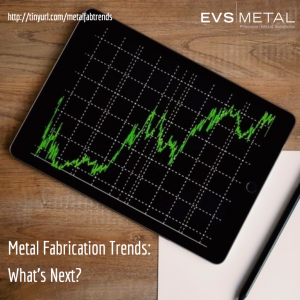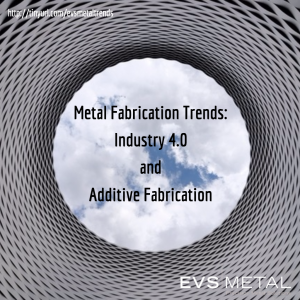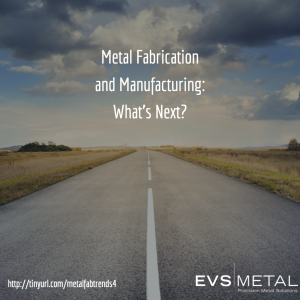Article Revised July 31st, 2022

The fabrication industry may not change as rapidly as others, but nevertheless, change is a-comin’, and those of us in manufacturing have to be ready to handle whatever the future throws at us. Here are nine sheet metal fabrication trends to watch for in 2021.
1. Industry Outlook
The global sheet metal fabrication market was valued at $76.980B in 2020 and is expected to grow at a CAGR of 3.1%, reaching $95.740B by 2027. The “market” in this case covers all different forms of fabrication, including metal cutting, machining, welding, punching, and forming. This is a solid if not stellar growth rate, and is about what we would have expected before starting our research. However, there are those businesses that are experiencing growth that is far outside of the average. Companies that fabricate aluminum, for instance, are seeing greater demand due to rising consumption, as are those that fabricate parts for the (quickly reshoring) automotive industry, commercial construction, and the aerospace sector. Essentially, there are still a number of incredible opportunities for growth; it’s simply a matter of staying nimble enough to adapt to what the market wants at any given time.
2. Greater Focus on Cybersecurity
The sheet metal fabrication industry may have been around for a long time, but that doesn’t mean that it hasn’t kept up with technology. Smart fabrication machines, IoT, connected shop floors, and Cloud-based software have all become common in most modern job shops over the past 5 years. This trend has meant that fabricators have had to start keeping a closer eye on what that means for the security of all of these systems. However, never has that been more important than in 2021, when ransomware hackers have taken up more than their fair share of headlines. The threat of a cyber attack could mean a complete loss of data, a massive data breach, or a huge amount of working capital lost to pay off hackers in order to ensure systems remain intact.
Interestingly, however, most cybersecurity breaches are not caused by a third party, but instead, internal human error. In fact, Cybint Solutions recently reported that as much as 95% of all incidents can be attributed to such. Additionally, the FBI has stated that cybercrimes increased a whopping 300% since the start of the COVID-19 pandemic. Given these numbers, it makes sense that manufacturers and metal fabricators are spending more resources to prevent these types of problems from occurring in the first place.
3. Reshoring
Reshoring is an interesting trend for metal fabricators to keep an eye on in the current market. We mentioned it briefly above, but it’s worth further exploration. Over the last decade, but in particular the last five years, many American companies have started to bring their foreign operations back home. Of course, it’s not patriotism driving this change; in reality, it’s being driven by increases in foreign wages in countries such as China and India, combined with market volatility and the rising costs of overseas freight transportation by both air and water. For fabricators willing to adopt new technologies such as automation and IoT — along with other aspects of Industry 4.0 — reshoring can mean a major boost to revenue as manufacturing jobs make their way back to the U.S. However, those who refuse to invest in the systems required to stay relevant are likely to quickly go the way of the dinosaur.
The metal fabrication industry is generally more stable than other industries, with fewer dramatic swings, but that doesn’t mean manufacturers don’t need to be prepared for change. This week, we’re featuring the second blog on metal fabrication trends that we believe will affect the market both in the near future and over the next decade.
Looking for precision sheet metal fabrication and machining services?

4. Automation
 The consistent rise in popularity of automated manufacturing systems is something that simply cannot be ignored by any company that wants to be in business ten years from now. Automatic controls are getting cheaper, faster, and more consistent, taking on more complex and varied tasks than they could even a few years ago.
The consistent rise in popularity of automated manufacturing systems is something that simply cannot be ignored by any company that wants to be in business ten years from now. Automatic controls are getting cheaper, faster, and more consistent, taking on more complex and varied tasks than they could even a few years ago.
Automation has been a key focus at EVS Metal. We’ve integrated it into multiple metal fabrication operations within our four facilities across the U.S. It allows us to ensure high-quality outputs, consistent productivity, and process stability that results in satisfied customers who are more likely to return. Automation allows us to meet our goal of maintaining the flexibility to produce items of almost any type, in a wide range of lot sizes, while delivering an exceptional customer experience, at the lowest possible cost.
5. Collaborative Robotics (Co-Bots)
Collaborative robots are those used to complete tasks that are more tedious, repetitive, or dangerous than humans should handle on their own. They are often seen in environments such as warehouses where packaging, packing, and palletizing items are a major part of the work completed. Although not yet commonplace in most metal fabrication environments, the global labor shortage is driving more fabricators to consider investing in “co-bots” for their job shop floors to complete more menial tasks.
6. Strategic Acquisitions
Every business eventually hits a plateau where growth slows. There are many ways to outsmart stagnation, and one common way is via strategic acquisition. This can mean different things to different people, but gaining a complementary set of capabilities via acquisition is one way to accelerate growth.
At EVS, we’ve always had an eye toward the future. This is why, over the last two decades, we’ve acquired several companies, which has allowed us to expand our facilities, capacity, and manufacturing offerings across the country. For instance, we purchased the assets of New Jersey precision machining shop, Jarco Industries several years ago, which immediately increased our machining capacity by 400% and expanded our ability to complete intricate mechanical assemblies. We’ve added other capabilities over the years with major acquisitions in New Hampshire (Keene) and Texas (Pflugerville-Austin).
7. Further Investment in Industry 4.0 Technologies
 We’ve talked about this multiple times already, but it bears repeating. Industry 4.0 is the trend that just keeps on, well…trending. At this point, it’s now made such strong headway into the metal fabrication and manufacturing industries that some aspects are now simply part of how things are done, in particular as it applies to automation. However, the “trend” aspects now pertain to “soft” automation, rather than “hard” automation.
We’ve talked about this multiple times already, but it bears repeating. Industry 4.0 is the trend that just keeps on, well…trending. At this point, it’s now made such strong headway into the metal fabrication and manufacturing industries that some aspects are now simply part of how things are done, in particular as it applies to automation. However, the “trend” aspects now pertain to “soft” automation, rather than “hard” automation.
Hard automation is the automation of physical machines, like welding or material-handling robots, and these have become more common over the last decade. However, soft automation — the type that tracks data — is still less common in many manufacturing environments, even though most researchers and analysts agree we’re reaching a tipping point in its use. Why? Sensors. As they become increasingly inexpensive, sensors — the basis of IoT, otherwise known as the Internet of Things — will soon be integrated into everything. Those sensors will allow manufacturers to track just about any aspect of their production, creating incredible opportunities for both micro-customization of products and wirelessly monitoring productivity via RFID in order to optimize production and workflow without any manual data inputting.
8. Additive Fabrication & Manufacturing (3D Printing)
While this type of fabrication is less common today, there’s no doubt that it will absolutely be considered part of the normal offerings available by many manufacturers. While additive fabrication technology can still be cost-prohibitive to deploy on a large scale, it is still an incredibly flexible, useful tool to add to a lineup of capabilities as the machines become less expensive to purchase and maintain. This is especially true for companies that specialize in high-mix, low-volume production where customization and personalization are often paramount, but must be balanced with efficiency and waste reduction as much as possible.
Looking for precision sheet metal fabrication and machining services?

9. Raw Materials Pricing
 For years, raw materials prices were falling, with iron ore reaching historic lows, while scrap metals, for the most part, remained relatively stable. Then COVID-19 hit, and in 2021, most raw material and scrap prices have skyrocketed. Oil increased by 58% in only 4 months. In fact, everything from wood to cotton has experienced enormous price increases. According to Bloomberg, steel futures in China have completed obliterated records, even outpacing gains in iron ore — a key ingredient in steel production. And the World Bank recently announced that even though the cost of many raw materials increased in 2020, 2021 was likely to see another 10% rise on average. This upward swing has caused many products to become more expensive — cost prohibitively so in some cases. The rising cost of raw materials, including steel and aluminum, has made everything from new and used cars to new construction homes unaffordable to many.
For years, raw materials prices were falling, with iron ore reaching historic lows, while scrap metals, for the most part, remained relatively stable. Then COVID-19 hit, and in 2021, most raw material and scrap prices have skyrocketed. Oil increased by 58% in only 4 months. In fact, everything from wood to cotton has experienced enormous price increases. According to Bloomberg, steel futures in China have completed obliterated records, even outpacing gains in iron ore — a key ingredient in steel production. And the World Bank recently announced that even though the cost of many raw materials increased in 2020, 2021 was likely to see another 10% rise on average. This upward swing has caused many products to become more expensive — cost prohibitively so in some cases. The rising cost of raw materials, including steel and aluminum, has made everything from new and used cars to new construction homes unaffordable to many.
10. Data-Based Decision Making
Enterprise resource planning (ERP) systems are now so rich and complex that they are able to easily gather data from throughout organizations and house everything in one secure place, whether cloud-based or on-premise. There it can be accessed by a variety of different applications and departments, enabling the system to support multiple individuals and workflows.
At EVS, we have found our ERP, MIE Trak Pro, to be an invaluable tool in streamlining processes and improving information flow throughout the company. The ability to share data from all different areas of our company in real-time has given us the opportunity to optimize productivity and create efficiencies across the board, in all four of our U.S. locations, from our shop floors to our warehouses to our corporate office in New Jersey. Using data-driven intelligence to drive business insights and translate them into actionable items via an ERP is just one way in which EVS stays ahead in a constantly-changing industry.
Interested in learning more about how EVS’s precision sheet metal fabrication capabilities can help with your next project? Get a quote online, or give us a call at 1-888-9EVSMET.





